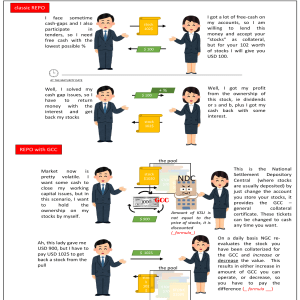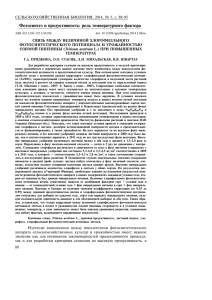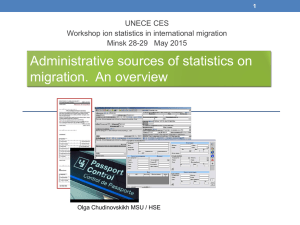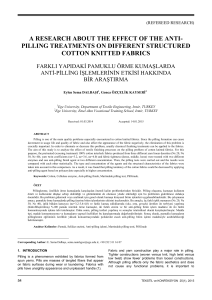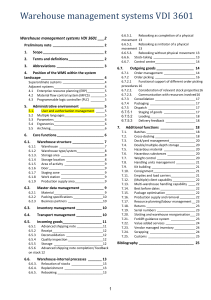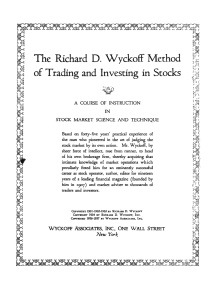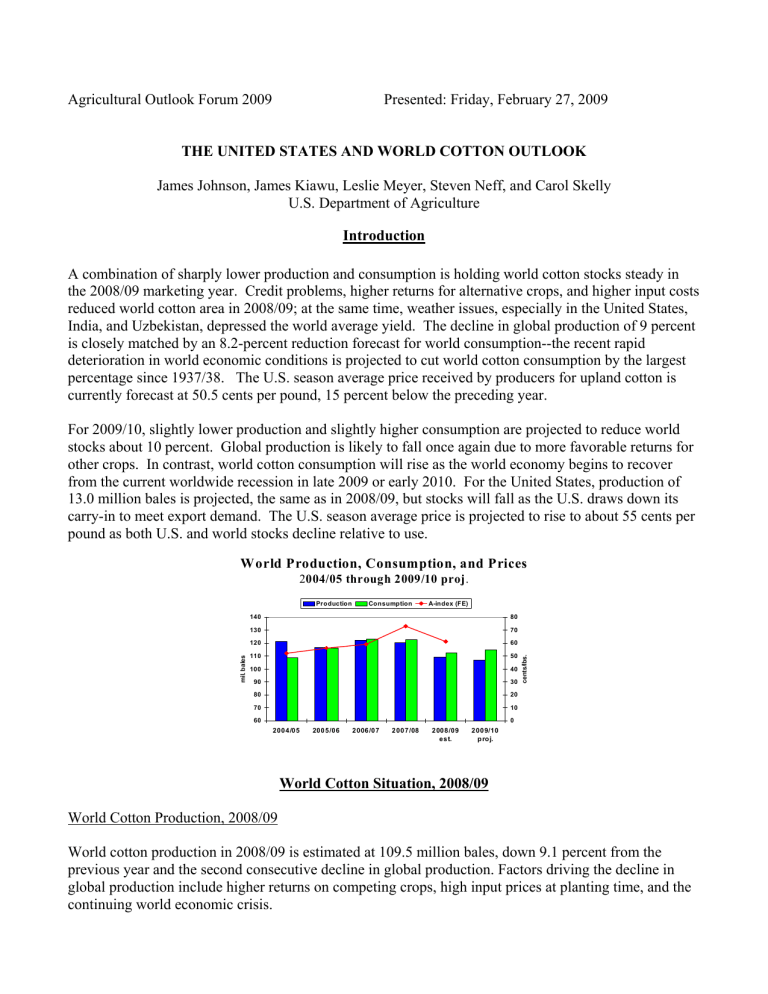
Agricultural Outlook Forum 2009 Presented: Friday, February 27, 2009 THE UNITED STATES AND WORLD COTTON OUTLOOK James Johnson, James Kiawu, Leslie Meyer, Steven Neff, and Carol Skelly U.S. Department of Agriculture Introduction A combination of sharply lower production and consumption is holding world cotton stocks steady in the 2008/09 marketing year. Credit problems, higher returns for alternative crops, and higher input costs reduced world cotton area in 2008/09; at the same time, weather issues, especially in the United States, India, and Uzbekistan, depressed the world average yield. The decline in global production of 9 percent is closely matched by an 8.2-percent reduction forecast for world consumption--the recent rapid deterioration in world economic conditions is projected to cut world cotton consumption by the largest percentage since 1937/38. The U.S. season average price received by producers for upland cotton is currently forecast at 50.5 cents per pound, 15 percent below the preceding year. For 2009/10, slightly lower production and slightly higher consumption are projected to reduce world stocks about 10 percent. Global production is likely to fall once again due to more favorable returns for other crops. In contrast, world cotton consumption will rise as the world economy begins to recover from the current worldwide recession in late 2009 or early 2010. For the United States, production of 13.0 million bales is projected, the same as in 2008/09, but stocks will fall as the U.S. draws down its carry-in to meet export demand. The U.S. season average price is projected to rise to about 55 cents per pound as both U.S. and world stocks decline relative to use. World Production, Consumption, and Prices 2004/05 through 2009/10 proj. Consumption A-index (FE) 80 130 70 120 60 110 50 100 40 90 30 80 20 70 10 60 cents/lbs. mil. bales Production 140 0 2004/05 2005/06 2006/07 2007/08 2008/09 est. 2009/10 proj. World Cotton Situation, 2008/09 World Cotton Production, 2008/09 World cotton production in 2008/09 is estimated at 109.5 million bales, down 9.1 percent from the previous year and the second consecutive decline in global production. Factors driving the decline in global production include higher returns on competing crops, high input prices at planting time, and the continuing world economic crisis. 2 E s tim a ted C h a n g e s in W o rld P ro d u ctio n , 2 0 0 8 /0 9 c o m p a re d w ith 2 0 0 7 /0 8 2 1 li a A u st ra an nz Ta is ak ia ta n ek P U zb a C h in yp t Eg rk e y il B ra z a .S di In Tu -2 U mil. bales . 0 -1 -3 -4 -5 -6 -7 China’s production in 2008/09 is estimated at 36.5 million bales, down 1.4 percent from the previous year. Area is estimated at 6 million hectares, representing a 3.2 percent reduction from the previous year, probably due to higher prices for food crops. Yield is estimated at 1,325 kg/ha, up 2 percent from the previous year. China’s cotton yields have been rising since the late 1990’s, with recent increases due mainly to area shifting to the high-yielding Xinjiang Autonomous Region. India’s 2008/09 production declined 6.5 percent from the previous year, to 23 million bales. Cotton area in that same period was estimated at 9.4 million hectares, a 2.1 percent reduction from the previous year and the first decline in acreage in five years. High food prices in India and low international cotton prices contributed to shifting area from cotton to grain production. India’s increasing use of the genetically modified (GM) cottonseed has generally resulted in significant yield dividends, but 2008 yields were adversely affected by an erratic monsoon. Pakistan’s 2008/09 production is estimated at 9.2 million bales, representing a 3.4 percent increase from a year earlier. Area declined slightly from the previous year while yield increased by 7 percent, making Pakistan one of a few major cotton-producing countries to realize a production gain in 2008/09. Yield is estimated at 691 kg/ha. In 2008/09, production in Brazil is estimated to decline 21.2 percent from 2007/08 to 5.8 million bales, the largest year-to-year reduction on record. As in several other major cotton producing countries, the ongoing liquidity crisis made it difficult for farmers to obtain credit in order to acquire inputs and expand cotton area; in addition, rising input costs have favored soybeans over cotton. Cotton planting is mostly completed by January. The planting timetable allows farmers to respond to better information about world market prices and to make production adjustments where necessary. Harvested area in 2008/09 is estimated at 885,000 hectares, down 17.8 percent from last year. Mato Grosso alone, Brazil’s highest cotton producing state, will likely account for about half of the reduction in area. Uzbekistan’s production is estimated at 5 million bales in 2008/09, down 9.1 percent from the previous year. Estimated area is at 1.4 million hectares, down marginally from last year. Farmers have been increasingly adopting the use of domestically developed cotton varieties which offer high yields, early maturity, and resistance to disease. Almost all the cotton crop is irrigated from melting snow from the Tien Shan and Pamir mountains. Drought, resulting in a shortage of irrigation, was a serious concern in 2008. 3 Australia’s crop, like Brazil’s, follows the southern hemisphere crop cycle. Production in 2008/09 is estimated at nearly 1.4 million bales, up 118 percent from a year ago. Cotton acreage is estimated at 160,000 hectares in 2008/09, up 146 percent from last year’s area. Severe water shortages have been easing due to improved precipitation in a country where an estimated 90 percent of the crop is irrigated. Yields are estimated at 1,837 kg/ha, short by 240 kg/ha from the previous year’s yield. Global harvested cotton area in 2008/09 is forecast at 31.1 million hectares, a reduction of 6 percent from the previous year. At the current estimate, world cotton acreage will be the lowest since 2002/03 when area harvested was 30.7 million hectares. World yield in 2008/09 is estimated at 768 kg/ha, down 23 kg/ha from a year ago. World Cotton Balance Sheet Beginning Stocks Production Imports Total Supply Exports Consumption Total Use Residual Ending Stocks Stock/Consumption % A-Index (cents/lb.) 2007/08 2008/09 Change (mil. bales) (mil. bales) (%) 62.8 120.5 38.0 221.4 38.4 122.7 161.1 -2.1 62.3 50.8 73.0 62.3 109.5 29.3 201.2 29.3 112.6 142.0 -2.5 61.7 54.8 61.0 -0.7 -9.1 -22.9 -9.1 -23.7 -8.2 -11.9 -1.0 World Cotton Consumption, 2008/09 World cotton consumption in 2008/09 is estimated at 112.6 million bales, down 10.0 million bales (8.2 percent) from last year. This will represent the largest year-to-year consumption decline since 1937/38. The ongoing global financial crisis largely explains this contraction in mill use. Developed economies, which are much more integrated in the global financial and trade systems, deteriorated more rapidly than developing economies in 2008/09. Data from the International Cotton Advisory Committee indicate that consumers in the developed economies account for about half of world cotton use. The International Monetary Fund projects in its January 2009 World Economic Outlook that world economic growth will weaken from the 3.4 percent in 2008 to 0.5 percent in 2009. In the advanced economies especially, economic growth is projected to contract further from the 1.0 percent in 2008 to -2.0 percent in 2009. These projections show a contraction in global output for the first time since World War II. In emerging and developing countries, growth in economic activity is forecast to slow from 6.3 percent in 2008 to 3.3 percent in 2009. 4 Cotton-Polyester Price Ratio Rose Slightly in 2008 1.4 1.3 Ratio 1.2 1.1 1 0.9 Trend 0.8 0.7 0.6 2008 2006 2004 2002 2000 1998 1996 1994 1992 1990 1988 1986 1984 1982 1980 Sources: Cotlook Ltd and PCI Fibre (2008 is Aug-Jan) . The price of cotton with respect to polyester increased marginally in 2008/09. Comparing AugustDecember 2008 to August-December 2007, the prices of both fibers fell, but polyester prices fell relatively more. The cotton-polyester price ratio is still well above the 2004-2006 period when world cotton consumption experienced rapid expansion. Thus, a lower cotton fiber share of world consumption is likely contributing to lower world cotton consumption this season. Consumption is expected to decline in 2008/09 in most of the world’s cotton-consuming countries. India, Pakistan, the United States, Brazil, and Turkey, together accounting for nearly 40 percent of world mill use, are expected to make sharp reductions in their 2008/09 consumption. India’s consumption is estimated at 17.2 million bales, down 6.0 percent from last year and the largest year-to-year decline in mill use ever recorded. In the United States, 2008/09 mill use will drop 15.4 percent to 3.9 million bales, the lowest U.S mill use seen since 1900. Pakistan’s 2008/09 cotton consumption is estimated at 11.5 million bales, representing a 7.3 percent decline from a year ago. Cotton mill use in Turkey is estimated at 4.7 million bales in 2008/09, down 21.7 percent from the previous year. However, cotton consumption is forecast to rise modestly in Bangladesh and Vietnam, where low labor costs and investment in spinning capacity are supporting demand. China’s Domestic Consumption and Trade China Cotton Balance Sheet Beginning Stocks Production Imports Total Supply Exports Consumption Total Use Residual Ending Stocks Stock/Use % 2007/08 2008/09 Change (mil. bales) (mil. bales) (%) 20.5 37.0 11.5 69.1 0.1 51.5 51.6 -2.5 20.0 38.8 20.0 36.5 6.5 63.0 0.1 47.0 47.1 -2.5 18.4 39.1 -2.6 -1.4 -43.6 -8.8 61.3 -8.7 -8.7 -8.0 5 China’s domestic consumption is forecast to fall nearly 9 percent in 2008/09 to 47 million bales, as the cumulative effects of sharply lower world demand, rising labor costs, tight credit, currency appreciation, and falling polyester prices have curtailed textile production for both domestic use and exports. China’s net cotton textile exports (raw fiber equivalent basis) grew more than 20 percent in January 2008, trended down to a growth rate of zero by December, and are likely to fall further in the first half of calendar 2009, as the slowing world economy continues to constrain textile demand. While data on use by consumers in China is less certain, the “hard landing” of China’s economy, which showed virtually no growth by some measures in the fourth quarter of 2008, is assumed to have cut retail demand sharply. The rapid deceleration in orders has left China’s mills with large inventories, resulting in either temporary or permanent idling of capacity. China’s imports are estimated to fall more than 40 percent to 6.5 million bales in 2008/09, the lowest imports since 2004/05, reflecting weakness in demand. China’s import level will also depend on the government’s policy with regard to release of cotton from the national reserve. Amidst growing turmoil in China’s economy, the government has been purchasing cotton as a means of stabilizing prices and farm income. As of early February, nearly 9 million bales of an overall target of 12.5 million had been taken into the reserve. A partial release of reserve stocks is expected before the end of the marketing year to meet mill requirements. If the government does not release reserve cotton, then imports will need to rise above the 6.5 million bales currently forecast. World Trade, Ending Stocks, and Prices Driven by the contraction in global consumption, total 2008/09 world import demand is falling by 23 percent to 29.3 million bales. This represents the largest year-to-year percentage decline in world trade since 1940/41. Double digit declines for imports are forecast in 7 of the top ten importing markets, led by a 44-percent decrease in China. The U.S. share of total world exports will rise considerably this year, even though U.S. exports will be below last year's level. Stock-holding policies in India and delayed government marketing in other countries, primarily in Central Asia, have provided an opportunity for U.S. cotton exporters to expand market share. While the world ending stocks forecast at 61.7 million bales for 2008/09 is down only marginally from the previous year, the ending stock position of major exporters will change substantially. Ending stocks in the United States will decrease by nearly 25 percent, while ending stocks in Central Asia and India are forecast to increase 45 and 23 percent, respectively. Due to the large decrease in global consumption, the stocks-to-consumption ratio will increase to 54.8 percent despite the slightly lower ending stock level. The A-index (Far East) has averaged about 63 cents per pound thus far this season, compared with 70 cents for 2007/08 and 59 cents for 2006/07, for the same period. In addition to the higher world stocksto-consumption ratio, a general decline in commodity prices is affecting the global cotton market. 6 U.S. Cotton Situation, 2008/09 Area and Production U.S. Cotton Area, Abandonment, Yield and Production Planted acres Harvested acres Abandonment rate Yield/harvested acre Production 2004/05 13.7 13.1 4.4 855 23.3 mil. acres mil. acres % lbs./acre mil. bales 2005/06 14.2 13.8 3.1 831 23.9 2006/07 15.3 12.7 16.6 814 21.6 2007/08 10.8 10.5 3.1 879 19.2 2008/09 9.5 7.7 18.4 810 13.0 U.S. cotton production in 2008/09 is estimated at 13.0 million bales, compared with last season’s 19.2 million, and the lowest production since 1989. As spring planting time approached for the 2008 crop, U.S. harvest futures prices for cotton averaged over 80 cents per pound for the December contract. However, prices for competing crops, like corn and soybeans, were also sharply higher in the spring of 2008. Consequently, relative net returns favored soybeans, in particular, and corn, to a lesser extent, over cotton in 2008. Final cotton plantings were estimated at about 9.5 million acres for 2008, the lowest in 25 years. Upland cotton area totaled only 9.3 million acres in 2008, 1.2 million (nearly 12 percent) below 2007 and the smallest crop planted since 1983. Extra-long staple (ELS) acreage declined a dramatic 40 percent to 174,000 acres, as relatively low prices for a second consecutive season pushed area lower. Most of the ELS decrease occurred in California where about 90 percent of the crop is grown. Planted area in 2008/09 was at its lowest since 2000/01, while the yield was marginally above the previous 5-year average. As a result, ELS production was cut nearly in half from the 2007/08 record crop to 447,000 bales. ELS Cotton Area, Production, and Yield 2003/04 to 2008/09 Production Yield 1000 1600 800 1400 600 1200 400 1000 200 800 0 lbs./acre 1,000 acres and bales Area 600 2003/04 2004/05 2005/06 2006/07 2007/08 2008/09 Despite a significantly smaller U.S. cotton planted area this season, the national abandonment rate was well above average and provided a lower-than-anticipated harvested area. The 2008 abandonment rate for the Southwest jumped dramatically from a quarter-century low of 4 percent in 2007 to 31 percent; in addition, abandonment rates in the Delta and the West regions were above average. Nationally, the 2008 abandonment rate totaled 18 percent. As a result, 2008 harvested area fell to its lowest level in 25 years, totaling only 7.7 million acres. 7 Weather conditions also played a key role in the yield outcome in 2008, despite technological advances-including new varieties, improved irrigation, and precision farming techniques--that have pushed the U.S. yield potential higher in recent years. In addition, the area shift out of the high-yielding West and Delta regions kept the national average yield below the last several seasons. The U.S. national average yield is estimated at 810 pounds per harvested acre in 2008/09, 69 pounds below last season's record and below the previous 4-year average of 845 pounds per harvested acre. U.S. upland cotton production in 2008/09 is estimated at 12.6 million bales, compared with last season's 18.4 million bales, and the lowest production since 1989. Although some States experienced better cotton crop conditions than a year ago, many States did not and overall U.S. conditions were well below average. In particular, drought conditions in Texas during the summer and abnormally cool weather in the fall led producers in the State to abandon nearly one-third of their cotton area, thus reducing production. Also, the effects of Hurricane Gustav led to relatively large area losses in Louisiana which lowered yield and the crop size there. The national average upland yield per harvested acre averaged 799 pounds, the lowest in 5 years. Compared with last season, 2008/09 upland cotton production was lower in three of the four Cotton Belt regions. The exception was the Southeast, where the upland crop approached 3.4 million bales. Despite the lowest area in 15 years, favorable growing conditions in the Southeast resulted in a record yield of 853 pounds per harvested acre and pushed the crop slightly above a year ago. Consequently, the Southeast crop accounted for nearly 27 percent of the U.S. cotton output in 2008/09, the highest since 2001/02. So uthea st R eg io n U pland C o tto n A rea , P ro ductio n, an d Y ield 2003 /04 to 2008 /09 Production Yield 1000 6 800 4 600 2 400 0 lbs./acre mil. acres and bales Area 8 200 2003/04 2004/05 2005/06 2006/07 2007/08 2008/09 In contrast, the Southwest and Delta regions each experienced significant declines in upland production this season. The Southwest crop is estimated at 4.9 million bales, nearly 3.7 million below 2007/08 and the lowest in 5 years. The decline resulted from a reduction in both harvested area and yield. Despite planted area above that of 2007, abandoned acreage of 1.6 million acres reduced harvested area to about 3.6 million acres. In addition, the regional yield was a below-average 656 pounds per harvested acre in 2008/09. Likewise, the Delta crop is estimated at nearly 3.5 million bales, about 1.8 million below 2007/08 and the lowest since 1986/87. Delta production contributed only 28 percent of the U.S. cotton crop in 2008/09, the lowest since 1983/84. Yields in the Delta region have been relatively stable over the past several seasons, averaging slightly above 2008/09’s yield of 930 pounds per harvested acre. 8 Southwest Region Upland Cotton Area, Production, and Yield Delta Region Upland Cotton Area, Production, and Yield 2003/04 to 2008/09 Yield Area Production Yield 10 1050 8 800 8 1000 6 600 6 950 4 400 4 900 2 200 2 850 0 mil. acres and bales 1000 0 2003/04 2004/05 2005/06 2006/07 2007/08 0 2008/09 lbs./acre Production 10 lbs./acre mil. acres and bales Area 2003/04 to 2008/09 800 2003/04 2004/05 2005/06 2006/07 2007/08 2008/09 In the West region, upland area declined for the fourth consecutive season to 292,000 acres—the region’s lowest since 1923/24—as upland area there continues to follow the downward trend experienced since the early 1980s. However, an above average yield of 1,420 pounds per harvested acre kept upland production in the West from falling further in 2008/09. The upland crop in the West totaled only 840,000 bales. Far West Region Upland Cotton Area, Production, and Yield 2003/04 to 2008/09 Production Yield 1600 2.5 1400 2.0 1200 1.5 1000 1.0 800 0.5 600 0.0 400 2003/04 2004/05 2005/06 2006/07 2007/08 2008/09 lbs./acre mil. acres and bales Area 3.0 9 U.S. Cotton Balance Sheet Beginning Stocks Production Imports Total Supply Exports Consumption Total Use Residual Ending Stocks Stock/Use % Farm Price (cents/lb.) 2007/08 2008/09 Change (mil. bales) (mil. bales) (%) 9.5 19.2 0.0 28.7 13.7 4.6 18.3 0.4 10.0 55.0 59.3 10.0 13.0 0.0 23.1 11.5 3.9 15.4 0.0 7.7 50.0 50.5 6.0 -32.1 -16.7 -19.5 -15.8 -15.4 -15.7 -23.3 Domestic Mill Use Domestic cotton mill use is forecast at 3.9 million bales for 2008/09, 700,000 bales or 15 percent below the 2007/08 estimate. The current mill use projection is less than half the level of cotton consumed by U.S. mills at the start of this decade and would be the lowest since 1900/01. U .S . C o t t o n M ill U s e 1 9 9 8 / 9 9 t o P re se n t 12 10 Million bales 8 6 4 2 0 1998 2000 2 002 20 04 200 6 2008 Marke ting year The significant declining trend in U.S. cotton mill use over the past decade has resulted from increased competition from imported textile and apparel products, especially from Asian sources. Since imports from Asia contain relatively little U.S. cotton yarn and fabric compared with sources in the Western hemisphere, U.S. mill use is affected both by the total volume of imports and by Asia’s increased share of U.S. retail demand. When the final apparel quotas were lifted in January 2005, the U.S. industry 10 faced additional pressure from imported products, particularly from China. In calendar year 2005, China replaced Mexico as the leading supplier of cotton textile and apparel products to the United States, accounting for about 19 percent of the 2005 total. U.S. imports are increasingly made in Asia, as China’s share surpassed 26 percent in calendar year 2008, with Pakistan continuing to account for about 10 percent of the U.S. market. During 2008, India’s shipments to the United States accounted for nearly 8 percent of total cotton product imports, while Mexico’s share decreased to about 7 percent. U .S . C o tto n T ex t ile I m p o rts S h a re b y O r ig in fo r T o p 5 S u p p lie rs (r a w fib er e q u i va le n t b a s is) 27 24 % share of total 21 18 2005 2006 2007 2008 15 12 9 6 3 0 C h in a P akista n In d ia M ex ico Ho n d u ra s As the general U.S. economy contracted in calendar year 2008, so too did U.S. cotton textile and apparel product trade. A reduction in cotton product imports in 2008 more than offset a decline in product exports, forcing the U.S. cotton textile trade deficit lower—a first since 1996. Although the cotton trade deficit—at 17.6 million bale-equivalents—declined in 2008, it was still one-third higher than the deficit in 2002. During 2008, U.S. cotton textile and apparel imports reached an estimated equivalent of 21.6 million bales of raw cotton, nearly 5.5 percent below 2007. In comparison, cotton product exports declined about 2.5 percent to an estimated 4.1 million-bale equivalents in 2008, or roughly 94 percent of domestic cotton mill use. This share continues to trend higher and is well above the 59 percent recorded for 2002, a time when the U.S. textile industry was spinning more raw cotton for the domestic industry. U.S. Cotton Textile Exports as a Share of Mill Use (raw fiber equivalent basis) 100 Percent 80 60 40 20 0 1998 2000 2002 2004 2006 2008 Calendar year As a result of the ongoing U.S. recession and the changes in U.S. cotton product trade and in the domestic spinning industry, estimated U.S. household consumption of cotton, as measured by U.S. mill 11 use plus net textile trade, is expected to decline in 2008/09. In calendar 2008, U.S. domestic consumption of cotton decreased to an estimated 21.9 million bale-equivalents, compared with 23.5 million in 2007. Similarly, U.S. per capita cotton consumption reached an estimated 34.5 pounds in calendar 2008, 3 pounds below the level of the last several years. U .S . D o m e s t i c C o tt o n C o n s u m p t i o n : T o t a l a n d P e r C a p it a P er c a p ita 40 20 38 15 36 10 34 5 32 0 Pounds mil. bale equivalents T ota l 25 30 199 8 200 0 2002 2004 2006 2008 Ca le n d a r ye a r Exports and Ending Stocks U.S. exports are forecast to fall to 11.5 million bales, the lowest since 2001/02, due to lower overall supplies and weak foreign demand. Export commitments were strong at the beginning of the season but the pace of sales and shipments has slowed in recent months, as foreign demand has weakened. The U.S. export forecast would constitute a relatively strong 39 percent share of total world exports, as U.S. cotton has been priced competitively relative to Indian and Central Asian cotton during the first half of the marketing year. U.S. ending stocks are forecast at 7.7 million bales, down 23 percent from the beginning level, but still an excessive 50 percent of total use. Prices and Farm Income Gross upland cotton farm income from the 2008 crop is estimated about 14 percent below 2007 at $6.4 billion. With respect to market income, lower prices and a much smaller crop combine to lower income 35 percent to $4.1 billion. Program payments are expected to about double as the lower prices increase marketing loan benefits and counter-cyclical payments. The upland cotton marketing year price has averaged 55.2 cents per pound for August through December 2008, an increase of 3 percent from the same period a year ago. Prices are expected to fall for the remainder of the season and the 2008/09 marketing year average price is forecast at 50.5 cents per pound. 12 billion $ G r oss C otton F a r m In com e 1 9 9 9 /2 0 0 0 th r o u g h 2 0 0 8 /0 9 e s t. 10 9 8 7 6 5 4 3 2 1 0 99 P ro gram M arke t 2000 2001 2002 2003 2 004 2005 2 006 2007 2 008 World Cotton Outlook, 2009/10 World Cotton Production, 2009/10 World cotton production in 2009/10 is projected at 107 million bales, representing a 2.3 percent decline from the previous year and the lowest output since 2003/04. This decline reflects significant reductions in China, Pakistan and the African Franc Zone countries, partially offset by higher production in India and Australia. The remainder of the world’s major cotton producers is projected to produce the same or slightly less cotton in 2009/10. Global harvested area is projected to fall to 29.7 million hectares while yield is expected to increase to 784 kg/ha. In China, 2009/10 production is forecast at 33 million bales, down 3.5 million bales (nearly 10 percent) from a year earlier. Cotton area is forecast at 5.35 million hectares, a decline of about 11 percent from the previous year. China’s cotton prices have been weakening and prices to farmers fell below expectations for the 2008 crop. The February 2009 China Cotton (CC) index of about 11,000 RMB per ton is down 19 percent from the year-ago level; at the same time, prices for food crops remain high enough to attract some acreage from cotton. State reserve purchases of cotton give some price assurance to cotton farmers, but the government is also supporting grain prices. Anecdotal reports suggest that area will be reduced at least 5 percent in the Xinjiang Autonomous Region and more than 10 percent in the eastern production regions. India’s 2009/10 production is projected at 24.5 million bales, higher than the previous year’s output by 6.5 percent. Area is projected to decline only marginally by 0.5 percent to 9.3 million hectares, mainly because cotton prices to farmers were supported by the government purchase program in 2008/09. The yield is expected to grow by 7.1 percent assuming normal monsoon conditions. The increased use of Bt cottonseed combined with improved crop management practices and irrigation systems are expected to support yields; however, the rate of increase in yields is slowing as Bt adoption reaches the saturation point. According to the government of India, Bt cotton now accounts for more than 70 percent of total cotton acreage in India. For Pakistan, production in 2009/10 is projected to decline to 8.9 million bales as compared to a year earlier. This production decline derives solely from an expected 3.3-percent area reduction with yields remaining steady. 13 Australia’s production is projected to rebound by 50 percent to an estimated 2.0 million bales in 2009/10. Acreage is projected to expand about 40 percent as recent precipitation has partially replenished irrigation supplies. The cotton yield in 2009/10 is expected to increase slightly to 1,960 kg/ha, about equal to the 5-year average. In the Franc Zone of sub-Saharan Africa, the 2009/10 crop is projected at 2 million bales, down more than 20 percent from 2008/09 and the lowest output recorded since 1987/88. Domestic structural and economic problems continue to weigh on farmer incentives. Cotton sectors in Burkina Faso, Benin, and Mali--three of the major producers in the bloc—are struggling as a result of low international cotton prices, exchange rate fluctuations, debt burden, and government policy choices. World Cotton Balance Sheet Beginning Stocks Production Imports Total Supply Exports Consumption Total Use Residual Ending Stocks Stock/Consumption % 2008/09 2009/10 Change (mil. bales) (mil. bales) (%) 62.3 109.5 29.3 201.2 29.3 112.6 142.0 -2.5 61.7 54.8 61.7 107.0 33.0 201.7 33.0 115.0 148.0 -2.5 56.2 48.9 -1.0 -2.3 12.5 0.3 12.5 2.1 4.3 -8.9 World Cotton Consumption, 2009/10 Recovery in world cotton consumption in 2009/10 will depend on economic growth and its effect on global textile demand, which is estimated to fall sharply in 2008/09. Most macroeconomic forecasts now project that world GDP growth will bottom in the third quarter of 2009 and begin to recover thereafter, albeit slowly. However, these forecasts typically also emphasize the considerable downside risks to recovery, due to the difficulty of clearing devalued assets from financial and corporate balance sheets, the sharp rise in unemployment, unprecedented weakness in consumer confidence, and uncertainty about the success of government intervention and stimulus plans (Oxford Economics, January 2009). 14 W orld C o tton C on sum p tion a n d E con om ic G row th 15 8 7 C o tto n 5 G DP 4 0 2009 2007 2005 2003 2001 1999 1997 1995 1993 1991 1989 1987 1985 1983 1981 -5 3 Percent, GDP 6 5 1979 Percent, cotton 10 2 1 -10 0 So u r c e s : US DA, In te r n a tion a l M o n e ta r y F un d , a n d G lob a lIn s ig h t . World cotton consumption has a history of rebounding sharply following periods of economic weakness, as the replenishment of yarn and textile inventories adds to the growth in consumer demand. With most forecasts of world GDP growth rising 2-3 percent for calendar year 2010, the resulting increase in world cotton consumption could reasonably be expected to rise above this level. However, mindful of the downside risks, USDA projects that 2009/10 world cotton consumption will rise 2 percent to 115 million bales, slightly below the 2005/06 level, prior to the rapid growth witnessed in the two subsequent marketing years. This projection is likely to understate potential consumption if economic recovery begins in fourth quarter 2009 and follows a typical historical pattern; on the other hand, the projection will prove optimistic if the expectations of world economic recovery fail to materialize. World Trade and Stocks, 2009/10 With lower world production and higher consumption, world trade is projected to recover to a level of 33 million bales in 2009/10, nearly 4 million bales above the estimate for 2008/09. Higher imports by China will be partially offset by lower imports in most of the developed economies. On the export side, India, and the countries of the African Franc Zone and Central Asia, are expected to recover market share due to large beginning stocks, more than offsetting a modest decline in U.S. exports. World ending stocks are projected at just above 56 million bales, a 9-percent decline from the beginning level, but still sufficient to support projected demand. 15 China Cotton Balance Sheet Beginning Stocks Production Imports Total Supply Exports Consumption Total Use Residual Ending Stocks Stock/Use % 2008/09 2009/10 Change (mil. bales) (mil. bales) (%) 20.0 36.5 6.5 63.0 0.1 47.0 47.1 -2.5 18.4 39.1 18.4 33.0 12.0 63.4 0.1 48.5 48.6 -2.5 17.3 35.6 -8.0 -9.6 84.6 0.6 0.0 3.2 3.2 -6.0 U.S. Outlook for 2009/10 Area, Production, and Supply U.S. Cotton Area, Abandonment, Yield and Production 2008/09 2009/10 Planted acres Mil. Acres 9.5 8.5 Harvested acres Mil. Acres 7.7 7.7 % 18.4 9.4 Yield/harv. Acre Lbs./acre 810 810 Production Mil. Bales 13.0 13.0 Abandonment rate USDA is currently projecting that U.S. cotton producers will plant 8.5 million acres in 2009, which would be the lowest planted area since 1983. Cotton planted area fell 12.5 percent in 2008, including reductions of about 30 percent in the Delta and West, while the Southeast reduced by 15 percent. Most of the decrease is attributed to higher prices for corn, soybeans, and wheat in combination with higher input prices that affect cotton more than most other crops. As was the case at this time a year ago, price relationships between cotton and most alternative crops remain unfavorable to cotton. Early industry expectations for 2009 are for a further drop of 5 to 10 percent in cotton plantings. However, the National Cotton Council’s (NCC’s) survey, released February 13, indicated that cotton area in 2009 would decline a further 14 percent to 8.1 million acres. Since that survey, prices for grains and soybeans have decreased, while cotton prices have shown considerable volatility, and have recently moved lower. The fluctuations in price signals to producers, combined with uncertain weather – particularly the dry conditions in Texas - suggest greater than normal uncertainty as the 2009 planting season approaches. 16 Harvest Futures Prices as of Feb-Mar Ratios of Corn and Soy to Cotton (2009 based on Feb. 1-13, 2009) Corn-to-Cotton Soy-to-Cotton 16 14 ratios 12 10 8 6 4 2 0 2004 2005 2006 2007 2008 2009 Attractive alternative crop prices - relative to cotton prices - are the main factor drawing acreage away from cotton again in 2009. With prices of major commodities other than cotton above their respective loan rates, 2009 planting decisions will be based mainly on expected market returns rather than government program benefits. Harvest futures prices in mid-February for corn ($4/bu), soybeans ($9/bu) are below a year ago, but remain favorable relative to cotton (50 cents/lb.). Winter wheat seedings were lower in 2008 than a year ago. While winter wheat acreage in Texas was higher than a year ago, dry conditions there may result in cotton following failed wheat if adequate moisture does not materialize. The NCC survey indicates that cotton acreage will decrease in all regions, with the Southwest, the Delta, and the Southeast combining to drop 1.2 million upland acres, while the West falls the most in percentage terms due to water shortages and further losses to alternative crops, especially tree crops and canning tomatoes. On March 31, USDA's National Agricultural Statistics Service will provide its first survey-based producer intentions for 2009 crop acreage. USDA is projecting production of 13.0 million bales, based on average abandonment of about 9.5 percent, and a national yield of 810 pounds per harvested acre. Abandonment in 2008 was unusually high and yields were lower than in 2007 due to difficult growing conditions, especially in Texas. In addition to assumed normal weather, 2009 yields are likely to remain even with the 2008-crop yields due to proportionally larger reductions in planted area for the two highest-yielding regions, the Delta and the West. Acreage and yields in 2009 will also be affected by weather conditions. While this analysis assumes normal weather, the National Weather Service’s (NWS’s) mid-February Drought Monitor shows abnormally dry conditions in the Southeast, severe drought in the San Joaquin Valley, and abnormally dry to exceptional drought in the Southwest. The NWS forecast is for drought conditions to persist in Texas and California’s San Joaquin Valley through the end of April. Since cotton is sometimes a preferred alternative for dry conditions, continued dryness could boost planted area, while also raising abandonment and reducing yields. 17 If realized, the production level of 13.0 million bales would be the same as in 2008 and the lowest production level since 1989/90. This projected production, in combination with the current beginning stocks estimate of 7.7 million bales (down 23%), results in U.S. cotton supply in 2009/10 of 20.7 million bales, the lowest since 1998/99. U.S. Cotton Balance Sheet Beginning Stocks Production Imports Total Supply Exports Consumption Total Use Residual Ending Stocks Stock/Use % Farm Price (cents/lb.) 2008/09 2009/10 Change (mil. bales) (mil. bales) (%) 10.0 13.0 0.0 23.1 11.5 3.9 15.4 0.0 7.7 50.0 50.5 7.7 13.0 0.0 20.7 11.0 4.0 15.0 0.0 5.7 38.0 55.0 -23.3 -0.3 0.0 -10.3 -4.3 2.6 -2.6 -26.0 U.S. Disappearance and Farm Price U.S. domestic mill use is projected to rise marginally in 2009/10 to 4.0 million bales, consistent with the projected recovery in the domestic economy. While the long-term trend in U.S. mill use is lower, mill use will fall below trend in 2008/09 and thus could achieve a slight rebound next season as cotton use at the retail level is expected to rise. 18 In contrast, U.S. exports are projected to decline slightly in 2009/10 to 11.0 million bales. The total U.S. cotton supply is projected nearly 2.0 million bales lower than 2008/09; in addition, the United States is likely to lose market share as foreign suppliers, such as India and Central Asia, draw down the surplus stocks accumulated in 2008/09. Accordingly, the United States is projected to realize a more modest one-third share of world trade. The U.S. share of world exports is projected at its lowest level since 2000/01. U .S . S h a r e o f W o r ld E x p o r t s 2 0 0 0 /0 1 th r o u g h 2 0 0 9 /1 0 p r o j . percent of world exports 45 40 35 30 25 20 20 00 /0 1 20 01 /0 2 20 02 /0 3 20 03 /0 4 20 04 /0 5 20 05 /0 6 20 06 /0 7 20 07 /0 8 20 08 /0 9 20 09 /1 0 Based on these projections of supply and use, U.S. ending stocks will fall to 5.7 million bales, equivalent to 38 percent of total use, following three seasons with stocks-to-use ratios of 50 percent or higher. With tighter stocks relative to use in both the United States and the world, the 2009/10 season average price received by farmers is forecast to rise about 9 percent to 55 cents per pound.
